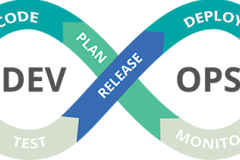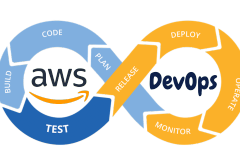About Cloudsoft:
Cloud Soft Solutions is leading training provider offers a comprehensive portfolio of technical training and education services designed for individuals, companies, and public organizations to acquire, maintain and optimize their IT skills. Cloud soft Solutions provide top notch training, IT outsourcing, and consulting for clients of all sizes, in a variety of industries.
Cloudsoft Vision
“Bridging Students' Aspirations and Companies' Expectations”
Devops
DevOps is a set of practices that automates the processes between software development and IT teams, in order that they can build, test, and release software faster and more reliably. The concept of DevOps is founded on building a culture of collaboration between teams that historically functioned in relative siloes. The promised benefits include increased trust, faster software releases, ability to solve critical issues quickly, and better manage unplanned work.
Under a DevOps model, development and operations teams are no longer “siloed.” Sometimes, these two teams are merged into a single team where the engineers work across the entire application lifecycle, from development and test to deployment to operations, and develop a range of skills not limited to a single function.
In some DevOps models, quality assurance and security teams may also become more tightly integrated with development and operations and throughout the application lifecycle. When security is the focus of everyone on a DevOps team, this is sometimes referred to as DevSecOps.
DevOps Classroom is designed to help you become a DevOps Engineer:
- Understand the concepts and necessities of DevOps
- Understand the need for DevOps and the day-to-day real-life problems it resolves
- Learn installation and configuration of common infrastructure servers like Apache.
- Learn popular DevOps tools like Jenkins, Ansible,Terraform,Docker,Kubernetes, Nagios and GIT
- Implement automated system update, installations and deployments
- Learn Virtualization,Container ,Mircoservices,Kubernetes, Concepts
- Configuration deployment and packaging, continuous integration using GIT,GITHUB,Jenkins
- Manage server operations using Code which is popularly known as Infrastructure as a Code(Terraform,AWS Cloud Formation ,Azure ARM templates)
Target Audience:
DevOps engineers are among the highest paid IT professionals today, and the market demand for them is growing rapidly. With emergence of new job roles around DevOpsphilosophy,anyone aspiring to get into these new roles, can take up this DevOps course. Some of these roles are:
- Automation Engineer
- Software Tester
- Security Engineer
- Integration Specialist
- Release Manager
- Scrum Masters
- System Adminsitrator
- Developers
- DevOps Architect
Course Content:
- Introduction to Devops
- Linux basics
- Linux admin level
- Shell Scripting
- Python Scripting
- Ansible
- Nexus,sonarqube
- Nagios
- Git,Github
- Ant
- Maven
- Jenkins
- Ansible
- Terraform
- Dockers
- Kubernetes
- Virtualization
- Cloud Computing
- ELK , Splunk , Promethues , Grafana
Introduction to Devops:
- Introduction to DevOps:
- Background
- Ingredients of DevOps
- DevOps principles
- Challenges
- DevOpsToolchain (Practices and Tools)
- SDLC vs Agile/DevOps:
- Agile Values and Principles
- What is conventional software development methodology
- Advantages of Agile
- Importance of DevOps in Agile
- What is Continuous Integration
- What is Continuous Delivery
- What is Continuous Deployment
- What is continuous feedback
- Faster deployments using devops
- Collaboration
- How Automation helps devops
- DevOps job market
1.Version Control System:
- Centralized and Distributed Systems
- SVN
- SVN Features
- SVN Server Installation
- Configure SVN with Web server
- Create and Configure Users
- SVN Trunk / Branch / Tag
GIT
- GIT Features
- 3-Tree Architecture
- GIT – Clone /Commit / Push
- GIT Hub Projects
- GIT Hub Management
- GIT Rebase & Merge
- GIT Stash, Reset , Checkout
- GIT Clone, Fetch , Pull
- GIT Merge Conflict
2.Differences between SVN & GIT
3.GitHUB
4.GIT Branching Strategy
Jenkins – Continuous Integration
Understanding continuous integration and Continuous Deployment
Build Cycle
Jenkins Architecture
Jenkins Master and Node configuration
- Installation of jenkins
- Jenkins Plugin Management
- Jenkins Backup and Restore
- How to integrate Jenkins with Ant
- How to integrate Jenkins with Maven
- How to integrate Jenkins with EKS,Gradle
- How to integrate Jenkins with Shell scripts
- How to integrate Jenkins with Python scripts
- Jenkins dashboard
- Jenkins authentication
- Jenkins plug-in – how to download and use
- Parameter zing the build
- Jenkins File and Jenkins Pipeline
- Jenkins Declarative and Scripted Pipeline
- Jenkins webhook Integration with Github ,Jenkins Triggers,Pollscm
- Jenkins integration with nexus and sonarqube
- Best Practices for Jenkins
Build Tools:
ANT
MAVEN
GRADLE
Ansible:
- Introduction to Ansible
- Ansible Architecture
- Ansible terminology
- Ansible commands
- How to add nodes to server
- Ansible installation and configuration
- Installing ssh on nodes
- Generating the keys
- Components of Ansbile
- Inventory
- Configuration
- Modules
- Playbooks
- Global Configuration
- Roles
- Tags
- How to write playbooks
- PYYAML overview
- How to write playbooks
- Ansible modules
- Ansbible Roles
- Ansible Galaxy
- How to download playbooks from Galaxy
- Realtime playbooks
- Troubleshooting
Terraform
- What is IAC
- IAC vs Configuration Management
- Terraform Installation and Commands
- Creating Infra through Terraform
- Terraform files
- Terraform Input,Output and local variables
- Terraform Data source ,Providers
- Terraform Modules,Provisioners,Resources
- Terraform State Management , Remote State file(S3)
Dockers & Containers
What are containers
- Difference between VM’s & Containers
- Hypervisor VsDocker Engine
- Docker Introduction
- Docker installation
- Images & containers basics
Images
- Docker Images Deep Dive
- Docker Hub
- Pull & Push images
- Building your own Image with Dockerfile
- Docker& Jenkins integration
- Hosting & Managing Images
Containers
- Deep Dive
- Running, Stopping, Deleting, Inspecting & Managing containers
- Docker networking ,Volumes
- Web server examples
- Local Development workflow
- Docker file and Multistage Dockerfile
- Docker Compose Docker Swarm
Docker Orchestration with Kubernetes
- Microservice Architecture
- Why Containers for microservices
- Kubernetes Intro & Architecture
- Kubernetes setup
- Running Docker containers on kubernetes
- Kubectl ,Kubeadm
- Pod ,Init containers ,Static Pods
- Service ,Service Type
- Replication controller & Replica Set
- Deployment ,Daemonset ,Stateful Set
- Ingress ,ISTIO
- Secretes ,Configmap , Namespaces
- Deployement and update Strategies
- PV ,PVC ,Storage Classes
- Designing High Avaiable Kubernetes Cluster
- Kuberntes Custom Resources
Kubernetes Integration with AWS and Azure
Nagios:
- Nagios Introduction
- Nagios Architecture
- How to install Nagios
- How to configure Nagios
- Plugins in Nagios
- How to add servers to Nagios
- NRPE – Nagios Remote Plugin Executor
- How to configure plugins on remote nodes
- Monitoring with Nagios
- Using the default plugins
- Writing our plugins
- Configuration of Nagios Server & Agent
- NRPE (Nagios Remote Plugin Executer)
- Configuration of Nagios.cfg and Contacts.cfg
- Monitoring Hosts
- Monitoring Services
- Monitoring Server Infrastructure
Linux:
- Linux Overview
- What is Operating sytem
- What is Unix, Linux
- Unix vs Linux
- Linux vs Windows
- Linux market trends
- Linux flavours
- Linux Architecture
- What is shell kernel command line utilities
- Linux Boot process
- Linux commands
- Linux admin level commands
- Reading files
- Redirection operators
- Piping
- User management
- Process management
- File system management
- Linux volume manager hands on
- Linux installation using iso
- Directory structure
- Editors
- VMware overview
Scripting:
- Shell scripting:
- She-bang line in shell
- Command line arguments
- Variables
- Loops
- Case statement
- Getopts
- Functions
- Regular expressions
- grep
- Awk
- Sed
Python scripting:
- Python Introduction
- Features of Python
- Python vs Perl
- Python vs shell
- Interactive mode of programming using python
- Reserved words
- Python indentation
- Python variables
- Python data types
- Numbers
- Strings
- Lists
- Tuples
- Dictionaries
- Loops
- Operators
- Break
- Continue
- pass
- Command line arguments
- Functions
- Lambda functions
- Modules
- Files
- Exception Handling
- Object Oriented concepts
- Class
- Object
- Inheritance
- Polymorphism
- Abstraction
- Method overloading
Software Methodologies:
- Waterfall Model
- Vmodel
- Agile/Scrum
Testing Tools:
- HP ALM
- Selenium
- Junit
- Bugjilla
Other Devops Tools:
- Terraform
- Nexus
- Jira/Grasshopper
- Service Now
- ALM
- SPLUNK
Cloudsoft Supports on:
- Practical Implementation
- RealTime Project
- Hands on Experience on Configuration Management, Deployments
- Resume Preparation
- Mock Interviews
- Real Time Interview Questions
- Consultancy
- Job References
- PROXY Support
More than 10 Lakh Jobs are coming on cloud in INDIA
Key features offered:
- More than 5500+ Success Stories at Cloud Soft Solutions. More than 4500+ Cloud Soft Candidates Placed in Top MNC’s.
- Real Time Scenarios, Case studies Exercises Troubleshooting, Interview tips with this 100% Job guarantee
- You will receive top quality Learningthat Cloud Soft Solutions is famous for in the class room as well as in Online & Corporate trainings.
- Training session are conducted by real-time instructors with real-time examples, use cases and Best training material
- Training will be provided on Systems, State-of-the-art lab with required software for practicing with 24*7 Lab
- Resume preparation and job referrals, Mock Interviews and Consultancy Services









